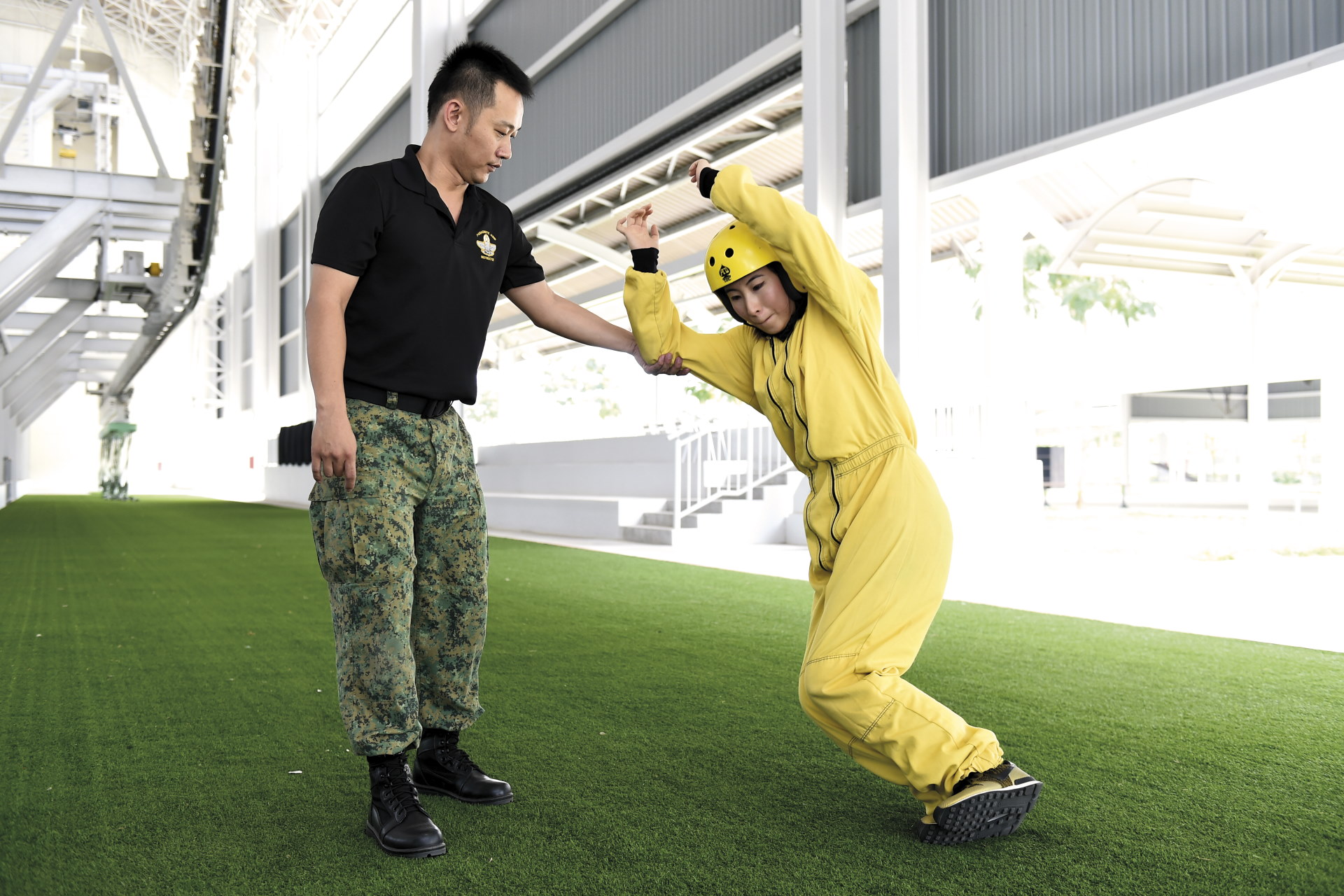OPS & TRAINING
THE JUMP
21 Dec 2015
Journalist Jing Ting puts her fear of heights to the test at the Parachute Training Facility.

Journalist Jing Ting puts her fear of heights to the test at the Parachute Training Facility.

I'm standing at the edge of the platform. My legs are shaking. The safety instructor is tapping the back of my right calf, telling me to make the leap.
I hear my photographer asking me: "Eh you really very scared hor? Your face very green leh." As I look down again, I feel sick and grip the railing with my sweaty palm. At last, I close my eyes, scream and jump!
Learning the ropes

No, I wasn't bungee-jumping - I was trying my hand at a part of the Basic Airborne Course.
Commando trainees take 10 days to go through ground training at the Parachute Training Facility in Pasir Ris Camp before moving on to their final airborne jump at 1,000ft (about 305m).
My instructor for the day, Master Warrant Officer (MWO) Oh Beng Lee, began by teaching me the proper parachuting landing technique.

Two other instructors - 2WO Lim Chun Heng and Master Sergeant (MSG) Jeffery Heng - demonstrated a side landing. This means keeping both legs and feet together; tilting the side of your body to the direction of the wind and your parachute; then falling to the ground, calves first. Once the rest of your body hits the ground, roll and bring both legs over to the other side.
While they did it effortlessly, I looked like a clumsy duck trying to roll over in vain.

Next, I was strapped to the Landing Trainer System (LTS) and raised to a height of 24ft. It was not as bad as I thought it would be, after I got over the initial shock of having my legs dangling so far from the ground. I gave MWO Oh the thumbs up, and he said he was confident that I would be able to make the jump from the last station.
At 28 pounds for the parachute and 10 pounds for the reserve chute, carrying the load around is no joke!
Going through the motion
The Rotational Trainer System (RTS) is the second stage, where trainees practise controlling the parachute by pulling the toggles according to the wind direction, and learn how to untangle their parachute in mid-air.

"Use your core muscles to kick one leg over the other while rotating your body to untangle your parachute lines," explained MWO Oh.
Hanging in mid-air as I tried to kick my left leg over my right, I quickly became exhausted. My abdominal muscles were burning and my legs weighed a ton. Before I started, I envisioned myself doing swift leg kicks in the air like Bruce Lee. In reality, I looked like Sesame Street's Big Bird caught in barb wire.
On the edge

Finally, it was the big moment. I stood at the edge of the Airborne Trainer System (ATS) platform.
Said 2WO Lim: "Keep your hands on the reserve chute. Move your left foot out onto the edge and lift your right foot to jump off. Once I tap you on the shoulder, jump."
He tapped. My body recoiled and I let out a small scream as I moved forward slightly. He tapped me again. I screamed again and grabbed the railing.
Another safety officer, who was on my right, said: "Just jump. You'll only feel a bouncing effect - it won't feel like you're falling. I'm going to tap your right calf, then you jump okay?"
With that, he tapped my right calf and said: "Go!" I jerked back instead. He did it a few more times, each time harder than before. My reaction remained the same. After several more tries, I began feeling guilty for wasting everyone's time.
Here goes nothing
Taking a deep breath, I looked straight, let go of the railing, and leapt off with a loud scream.

By the time I recovered from my fear, I was mid-way through the ATS track. I looked down in awe and started toggling left and right. At a speed of 2m/s, it wasn't long before I began descending.
As my feet hit the ground, I was greeted by a smiling MWO Oh. "See, it's not that bad, right?"
I smiled meekly and apologised for taking so long. To my surprise, he told me I was only at the platform for three minutes.

"If you really have a fear of heights, you wouldn't dare to stand near the edge. I've seen some guys who can't even go near it," he added. "It's scientifically proven that once you can jump at 37 feet, you can jump at 1,000 feet. That's why we built the platform at that height. So, do you want to jump?"
For now, I'm just glad that I accomplished my task. My only hope is that I did not leave everyone with the impression that I was a screaming wreck. After all, I was pretty brave. Right?
ALSO READ IN OPS & TRAINING

Exercise Wallaby 2025: To see better, shoot faster
31 Oct 2025
The SAF focuses on complex strike missions and multi-domain integration in Exercise Wallaby 2025, the 35th edition of its largest unilateral overseas exercise.

Ex Wallaby 25 – Greater Integration and Complexity
25 Oct 2025
The 35th edition of the SAF’s largest unilateral overseas exercise is an opportunity for expanded scale and deeper integration towards an effective, networked fighting force.

Ex Forging Sabre ramps up use of unmanned assets in integrated strike operations
12 Sep 2025
In this 10th edition of Exercise Forging Sabre, the SAF sharpened its cutting edge for the dynamic modern battlefield, with expanded integration between manned and unmanned platforms.


